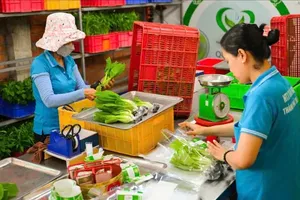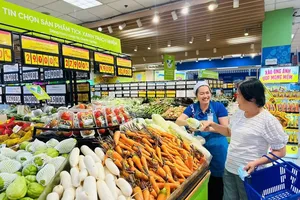
Online platforms
According to statistics, during the peak period of the pandemic in July 2021, the online website Tiki recorded 10,000 orders per day for essential items. Lazada recorded five to ten tons per day for green vegetables and processed foods. According to Mr. Tran Ngoc Thai Son, CEO of Tiki, the speed of transition from traditional model to the modern online style of buying is happening too fast. During the fourth wave of the pandemic, most of the essential items such as food products, medical equipment, medicines, and household appliances, were all ordered online. Many industry groups that seemed reluctant to go on e-commerce platforms earlier, such as the fresh food retailers, quickly adopted this new method of taking online orders during the pandemic, especially during the phase of strict social distancing regulations. Currently this group is a strong retailer on various online platforms across the country.
By observing shopper behavior, businesses must also quickly change and adapt during the pandemic when transitioning to a new change in trend. According to a survey of 15,000 retailers by Sapo Technology Company, digital transformation and shifting sales to cyberspace have exploded the maximum during the fourth wave of the pandemic. Compared to 2019 and 2020, the solution chosen by retailers in 2021 was to promote sales on diverse e-commerce floors and online platforms. Accordingly, 72.8% of businesses converted from offline to online, up 9% compared to 2020 when only 63.8% business were online. The percentage of sellers doing business offline and not doing business online also decreased from 36.2% in 2020 to 20.9% in 2021.
Many online business records have been made, especially on e-commerce floors on super sale occasions. For example, the e-commerce platform Shopee recorded that the number of orders at its store increased 14 times on 12 December 2021, compared to the average daily rate. The brands on the booth also attracted many new users, whereby one out of eight users shopped there for the first time. Online retailing is not only booming on mainstream e-commerce platforms but is also very active on social network sites such as Facebook and TikTok. Reports by Google, Temasek, and Bain & Company show that in terms of scale, Vietnam's e-commerce market in 2021 grew to 53 percent from 2020, to touch US$13 bn. According to the same report, from the start of the pandemic until the first half of 2021, Vietnam added eight million new digital consumers, with more than half of them coming from smaller towns and cities.
However, Google, Temasek, and Bain & Company estimate the actual market size may be larger than the statistics shown, because these figures only calculate the size of official e-commerce transactions made through a professional online retail platform. As sellers and buyers exchange information through messages, chat groups on social networks, or messaging applications, it is difficult to measure all sales, because the e-commerce unofficial platform is also quite active in Vietnam.
E-commerce fraud
The Covid-19 pandemic has caused the number of sellers and buyers on online platforms to increase rapidly, and online retail has had an explosive year in 2021. However, it is to be seen where this trend will continue to be adopted by consumers once the pandemic is finally brought under control, which is difficult to tell.
According to a recent survey by Vietnam Report Joint Stock Company (Vietnam Report) with consumers, more than 45 percent of survey respondents said they would shop online less when pandemic is over. Although many stores are closed now during the ongoing pandemic, this does not mean that they are no longer important. E-commerce will not altogether replace physical stores. When the pandemic is under control, customers will return back to brick-and-mortar stores as the experience cannot be replicated online and also it is the perfect place to introduce new items in gatherings of people.
Another important reason why the boom may be difficult to sustain is that the quality of goods on online channels remains a sore point for consumers and regulators. There is the problem of selling fake or poor-quality goods via e-commerce platforms. In the past, sellers often took pictures of products and then posted them for sale and were suspected of editing photos, but now to create more visual images, many sellers live stream some products. When live streaming, sellers use genuine goods to introduce, but when it comes to customers buying, then it may not be the same product at time of delivery. After buying on e-commerce platforms, customers can complain, exchange, and return goods, but it also takes a lot of time, so with low-value items, customers often ignore this feature. Customers buying on social network sites often prefer to forgo the money rather than go through the hassle of returning the product. Therefore, to avoid spending money to buy fake goods, many consumers will still prefer to go to real stores to choose and buy products.
Many fraud businesses live streaming on social network sites have been shut down by authorities. Nonetheless, violators are getting bolder because profits are so high. By October 2021, the market management force nationwide had inspected nearly 2,500 cases of fraud sites and handled over 2,300 violations, including violations in e-commerce and abusive acts. E-commerce sites trading in smuggled goods, goods of unknown origin, goods infringing upon intellectual property rights, and counterfeit goods, were fined over VND 18 bn. According to a forecast of the Ministry of Industry and Trade, in the next two to three years, the rate of commercial fraud on e-commerce sites will grow by about 50 percent to 60 percent.
More recently, the Government issued Decree 85/2021/ND-CP amending and supplementing Decree 52/2013/ND-CP on e-commerce issues. In addition to the management of traditional e-commerce platforms, online business activities on social network sites are also included in management. The Decree takes effect from 1 January 2022, and is expected to help manage online sales more effectively and efficiently.
























